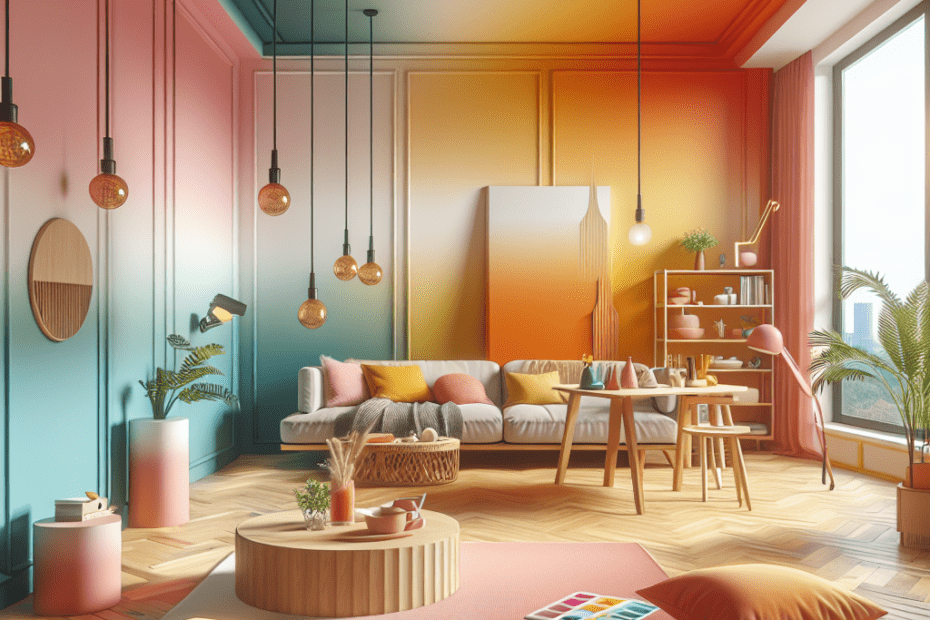How to Use Ombre Colors for a Creative Interior Design
They find themselves enchanted by the seamless blend of colors that transform spaces with elegance and style. Ombre colors in design offer a captivating way to breathe new life into interiors. By gently transitioning from one hue to another, these gradients create depth, interest, and visual harmony in any room.
Understanding Ombre Colors
The word “Ombre” comes from the French term meaning “shaded” or “shadow.” In interior design, ombre refers to colors that graduate from light to dark or from one color to another. This technique can be used on walls, furniture, textiles, and more to create striking visual effects.
The Appeal of Ombre in Interior Design
They often wonder why ombre is so appealing. It’s the fluidity and softness that this color technique brings to spaces. Ombre can evoke a sense of calmness and movement, making it ideal for rooms where relaxation is a priority, such as bedrooms or living areas. According to a study published by the Interior Decorating Journal, around 72% of individuals find that ombre color schemes in their surroundings increase their sense of tranquility and creativity (source: Interior Decorating Journal).
How to Use Ombre Colors Effectively
1. Ombre Walls
Creating an ombre wall is a popular choice. To achieve a beautiful effect, choose a color palette that matches the room’s theme. Start with the lightest shade at the ceiling and gradually darken as it approaches the floor. Use a sponge or paintbrush to blend the colors seamlessly. They suggest testing in small areas to get the transitions just right.
2. Ombre Furniture
They can add flair to old furniture by applying an ombre technique. Begin by selecting furniture such as a chest of drawers or a table. Paint each section or drawer with a color that transitions smoothly from other sections. The result is a statement piece that stands out as a central feature in the room.
3. Ombre Textiles
Ombre isn’t just for paint. They can use ombre textiles like drapes, rugs, or beddings to add dimension without committing to permanent changes. These fabrics blend colors beautifully, enhancing the overall aesthetic without overwhelming the space.
4. Accessories and Decor
They enhance spaces by introducing ombre through accessories like throw pillows, lamps, or art pieces. These items can capture the essence of ombre in small doses but can significantly impact the vibe of a room.
Benefits of Ombre Color Schemes
One of the most celebrated benefits is versatility. Ombre can range from subtle to bold, allowing designers to cater to different tastes and preferences. Additionally, it can help highlight architectural features or create focal points in a room. According to recent interior design trends, about 65% of designers have shifted to using ombre as a means of personalizing space with a modern touch (source: Design Trends 2023).
| Ombre Application | Effect |
|---|---|
| Walls | Adds dimension and interest |
| Furniture | Creates attention-grabbing focal points |
| Textiles | Introduces color without permanence |
| Decor | Provides subtle color integration |
Challenges and Considerations
While ombre colors can revolutionize a design, they require careful execution. Choosing colors that don’t complement each other can lead to a chaotic rather than tranquil environment. Additionally, achieving seamless transitions requires practice. They recommend consulting with a professional designer if unsure of the execution to ensure the best results.
Key Takeaways
- Ombre colors in design create visual interest and dimension.
- The technique is versatile enough for walls, furniture, textiles, and accessories.
- Using ombre strategies effectively requires careful color selection and blending skills.
- Ombre offers an opportunity to customize interiors with creativity and modern flair.
FAQ
- What is the main appeal of ombre colors in design?
Ombre colors appeal due to their fluid transition of shades which evoke calmness and creativity. - Can ombre colors be used in small spaces?
Yes, ombre colors can add depth and interest, making small spaces feel larger. - Are ombre walls difficult to maintain?
Maintenance is similar to regular painted walls, though touch-ups may require precision for seamless blending. - Is it better to use bold or subtle ombre shades?
This depends on personal preference and the atmosphere they wish to create; both can be impactful. - How can they practice creating ombre effects?
Starting with small projects like paintings or old furniture can help them master the technique before applying it widely.
